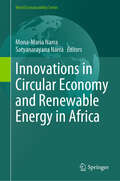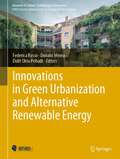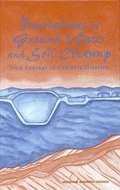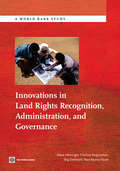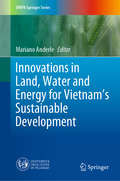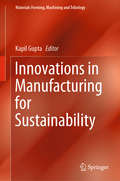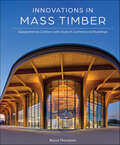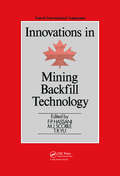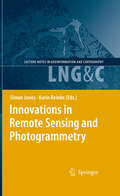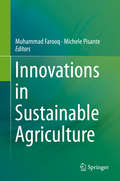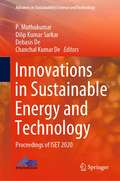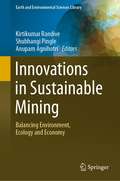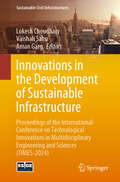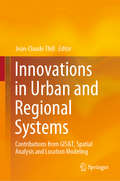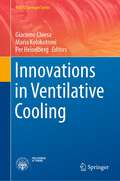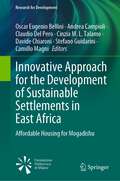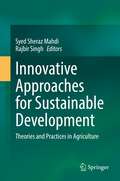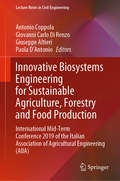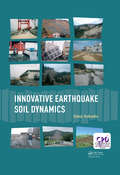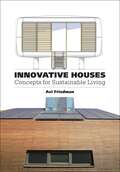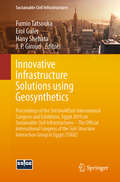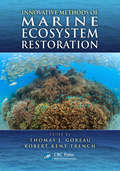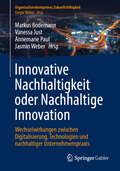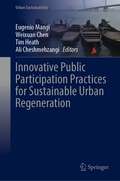- Table View
- List View
Innovations in Circular Economy and Renewable Energy in Africa (World Sustainability Series)
by Mona-Maria Narra Satyanarayana NarraIn many African countries, access to electricity and modern energy fuels remains a significant concern. Over 570 million people in Sub-Saharan Africa still lack electricity, and only 18% have access to modern cooking fuels. The region faces immense challenges, including massive debts, lack of maintenance, and system failures, underscoring the urgent need for investment in the energy sector's transition. Africa's overreliance on fossil fuels and the growing demand for energy, driven by economic expansion and population growth, could lead to sharp increases in greenhouse gas emissions. Meanwhile, urbanization, economic activities, and rising living standards are increasing waste production, making waste management a pressing issue. The absence of adequate waste treatment technologies, financing, and regulatory frameworks exacerbates this challenge. Biomass remains a predominant energy source in Sub-Saharan Africa, often used in its raw state, leading to health hazards from incomplete combustion. However, the continent's abundant agricultural residues and other energetic wastes offer a significant opportunity. These can be transformed into various energy carriers, helping to meet or supplement Africa's energy and fuel needs. The current situation presents a unique opportunity for Africa to shift from a fossil-based economy to a sustainable green economy. Leveraging technology, knowledge, and skills can support this rapid transition and drive economic growth. Innovations in Circular Economy and Renewable Energy highlights current advancements in waste management, biomass utilization for energy, and innovations in green hydrogen production in Africa. This book showcases predominantly African research and insights first presented at the "First International Conference on Circular Economy, Renewable Energy, and Green Hydrogen" in Kumasi, Ghana, in September 2023. Dive into this essential resource to explore transformative waste-to-energy technologies, the hybridization and flexibilization of renewable energy systems, and the path towards a sustainable future for Africa.
Innovations in Green Urbanization and Alternative Renewable Energy (Advances in Science, Technology & Innovation)
by Federica Rosso Donato Morea Didit Okta PribadiThis book thoroughly examines the aims of green urbanism, providing a perspective to help responding to the growing environmental challenges posed by the enormous increase in human needs. The book gives insights about architectural intervention in urban planning which provides green design strategies in a way that improves the efficiency of building in terms of energy consumption and environmental conservation. The book also gives attention to the paradigm of the `intermediate city’, thus, helping in overcoming the challenges posed by the growing urbanization process. Finally, the book gives a futuristic vision of cities, anticipating their challenges and providing possible solutions for them. The book targets a wide audience interested in implementing the SDG goals in energy and green urban planning, and those interested the interdisciplinary nature of green urbanization and alternative and renewable energy accommodates.The book is a culmination of selected research papers from the 4th version of the International Online Conference on Green Urbanism (GU) of Roma Tre University, Italy (2020) & the 3rd version of the International Online Conference on Alternative and Renewable Energy Quest (2020).
Innovations in Ground Water and Soil Cleanup: From Concept to Commercialization
by Committee on Innovative Remediation TechnologiesMost books on ground water and soil cleanup address only the technologies themselves--not why new technologies are or are not developed. Innovations in Ground Water and Soil Cleanup takes a holistic approach to the entire field, addressing both the sluggish commercial development of ground water and soil cleanup technologies and the attributes of specific technologies. It warns that, despite cleanup expenditures of nearly $10 billion a year, the technologies remain rudimentary.This engaging book focuses on the failure of regulatory policy to link cleanup with the financial interests of the company responsible for the contamination. The committee explores why the market for remediation technology is uniquely lacking in economic drivers and why demand for innovation has been so much weaker than predicted.The volume explores how to evaluate the performance of cleanup technologies from the points of view of the public, regulators, cleanup entrepreneurs, and other stakeholders. The committee discusses approaches to standardizing performance testing, so that choosing a technology for a given site can be more timely and less contentious. Following up on Alternatives for Ground Water Cleanup (NRC, 1994), this sequel presents the state of the art in the cleanup of various types of ground water and soil contaminants. Strategies for making valid cost comparisons also are reviewed.
Innovations in Land Rights Recognition, Administration, and Governance
by Paul Munro-Faure Clarissa Augustinus Stig Enemark Klaus DeiningerThe importance of good land governance to strengthen women's land rights, facilitate land-related investment, transfer land to better uses, use it as collateral, and allow effective decentralization through collection of property taxes has long been recognized. The challenges posed by recent global developments, especially urbanization, increased and more volatile food prices, and climate change have raised the profile of land and the need for countries to have appropriate land policies. However, efforts to improve country-level land governance are often frustrated by technical complexities, institutional fragmentation, vested interests, and lack of a shared vision on how to move towards good land governance and measure progress in concrete settings. Recent initiatives have recognized the important challenges this raises and the need for partners to act in a collaborative and coordinated fashion to address them. The breadth and depth of the papers included in this volume, all of which were presented at the World Bank's Annual Conference on Land Policy and Administration, illustrate the benefits from such collaboration. They are indicative not only of the diversity of issues related to land governance but, more importantly, highlight that, even though the topic is complex and politically challenging, there is a wealth of promising new approaches to improving land governance through innovative technologies, country-wide policy dialogue, and legal and administrative reforms. The publication is based on an on-going partnership between the World Bank, the International Federation of Surveyors, the Global Land Tool Network and the United Nations Food and Agriculture Organization provide tools that can help to address land governance in practice and at scale. It is our hope that this volume will be of use to increase awareness of and support to the successful implementation of innovative approaches that can help to not only improve land governance, but also thereby contribute to the well-being of the poorest and the achievement of the Millennium Development Goals.
Innovations in Land, Water and Energy for Vietnam’s Sustainable Development (UNIPA Springer Series)
by Mariano AnderleThis book presents recent innovative trends in land, water and energy management in Vietnam. Presenting the main projects and outcomes of a close collaboration between Italian and Vietnamese researchers in the last three years, the book is divided into three main sections: environment, climate change and land management in Vietnam; energy for Vietnam; and cities and utilities in Vietnam. The first section focuses on water systems, including rivers and seacoasts, and on new growing methods for more sustainable agriculture. The second section addresses energy and wastewater. The country’s rapid growth is a major challenge in terms of reinforcing the electrical infrastructures, and as such this section offers an overview of the government’s planned measures and their impact on the Vietnamese power system. The third section highlights cities and utilities in the context of increasing urbanization, exploring the urban morphology of the Vietnamese metropolis, particularly Hanoi and Ho Chi Minh City.
Innovations in Manufacturing for Sustainability (Materials Forming, Machining and Tribology)
by Kapil GuptaThis book provides details on the innovations made to achieve sustainability in manufacturing. It highlights the trends of current progress in research and development being done to achieve overall sustainability in manufacturing technology. Green-EDM, Hybrid machining, MQL assisted machining, sustainable casting, welding, finishing and casting, energy- and resource-efficient manufacturing are some of the important topics discussed in this book.
Innovations in Mass Timber: Sequestering Carbon with Style in Commercial Buildings
by Boyce ThompsonTrending topic on which there are few books, none written from a purely design point of view. Wooden Buildings Reach for the Skyhttps://www.nytimes.com/2021/07/30/todaysinyt/wooden-buildings-reach-for-the-sky-in-vaxjo-sweden.html?referringSource=articleShareFive Stories Tall and Made of Woodhttps://www.nytimes.com/2020/01/17/realestate/five-stories-tall-and-made-of-wood.html?referringSource=articleShareAs Concerns Over Climate Change Rise, More Developers Turn to Woodhttps://www.nytimes.com/2020/09/22/business/mass-timber-wood-buildings.html?referringSource=artichttps://www.nytimes.com/2019/11/20/style/engineered-wood-tower-construction.html?.?mc=aud_dev&ad-keywords=auddevgate&gclid=Cj0KCQjwg7KJBhDyARIsAHrAXaHHY8errrxRyekMa3u1yfaO3-hlB6P4tpWt23X1l9NnbkdQxH2J8z8aAtAcEALw_wcB&gclsrc=aw.ds
Innovations in Mining Backfill Technology
by F.P.HASSANI; M.J.SCOBLE; T.R.YUProceedings of the 4th International Symposium held in Montreal, Oct.2-5, 1989. Paper topics include: review, laboratory testing, modelling and design, rockburst control, soft rock mining, and system design.
Innovations in Remote Sensing and Photogrammetry
by Simon Jones Karin ReinkeRemote sensing of our environment is becoming increasingly accessible and important in today's society. This book aims to highlight some of the broad and multi-disciplinary applications, and emerging practices, that remote sensing and photogrammetric technologies lend themselves to. The papers have been selected from the 13th and 14th Australasian Remote Sensing and Photogrammetry Conferences given by experts in remote sensing, spatial analysis and photogrammetry from across the Asia Pacific region. They are presented here as a collection of peer reviewed papers covering research into areas such as data fusion techniques and their applications in environmental monitoring, synoptic monitoring and data processing, terrestrial and marine applications of remote sensing, and photogrammetry.
Innovations in Sustainable Agriculture
by Muhammad Farooq Michele PisanteThis volume is a ready reference on sustainable agriculture and reinforce the understanding for its utilization to develop environmentally sustainable and profitable food production systems. It describes ecological sustainability of farming systems, present innovations for improving efficiency in the use of resources for sustainable agriculture and propose technological options and new areas of research in this very important area of agriculture.
Innovations in Sustainable Energy and Technology: Proceedings of ISET 2020 (Advances in Sustainability Science and Technology)
by P. Muthukumar Dilip Kumar Sarkar Debasis De Chanchal Kumar DeThis book presents best selected research papers presented at Innovation in Sustainable Energy and Technology India (ISET 2020), organized by Energy Institute Bangalore (A unit of RGIPT, an Institute of National Importance), India, during 3–4 December 2020. The book covers various topics of sustainable energy and technologies which includes renewable energy (solar photovoltaic, solar thermal and CSP, biomass, wind energy, micro hydro power, hydrogen energy, geothermal energy, energy materials, energy storage, hybrid energy), smart energy systems (electrical vehicle, cybersecurity, charging infrastructures, IOT & AI, waste management, PHEV (CNG/EV) and mobility (smart grids, IOT & AI, energy-efficient buildings, mart agriculture).
Innovations in Sustainable Mining: Balancing Environment, Ecology and Economy (Earth and Environmental Sciences Library)
by Kirtikumar Randive Shubhangi Pingle Anupam AgnihotriThis book explores sustainable mining knowledge, assessing researchers on the impacts of waste and new approaches to negotiating these impacts. Mining has always been a profitable venture; however, it comes with several boons and banes. The significant advantages of mining include employment generation, the establishment of townships and trade centers, and socio-economic growth. However, the mining activity is a significant cause of environmental degradation, including soils, atmosphere, water, solid wastes, changed topography, and health hazards. This book emphasizes value-added products from mining wastes and innovations for balancing environment, ecology, and economy. This book is designed for miners, policymakers, professionals, researchers, scientists, industrialists, and environmental agencies.
Innovations in the Development of Sustainable Infrastructure: Proceedings of the International Conference on Technological Innovations in Multidisciplinary Engineering and Sciences (TIMES-2024) (Sustainable Civil Infrastructures)
by Lokesh Choudhary Vaishali Sahu Aman GargThis book offers a comprehensive exploration of cutting-edge insights and research in sustainable infrastructure development, offering valuable solutions tailored to meet contemporary challenges. Encompassing a diverse range of topics such as green building technologies, climate-resilient infrastructure, smart applications, and low-carbon construction techniques, it presents essential knowledge for researchers, practitioners, policymakers, and stakeholders alike. With a keen focus on fostering innovation and promoting sustainable practices, this series serves as an indispensable resource for anyone invested in the advancement of sustainable infrastructure. Whether you're an academic seeking the latest research or a professional navigating real-world challenges, this series provides informative, engaging, and thought-provoking content to inspire action and drive positive change. To discover the roadmap to a greener, smarter future --this book series is your guide.
Innovations in Urban and Regional Systems: Contributions from GIS&T, Spatial Analysis and Location Modeling
by Jean-Claude ThillThis book presents cutting‐edge research on urban and regional systems applying modern spatial analytical techniques of Geographic Information Science & Technologies (GIS&T), spatial statistics, and location modeling. The contributions, written by leading scholars from around the globe, adopt a spatially explicit analytical perspective and highlight methodological innovations and substantive breakthroughs on many facets of the socioeconomic and environmental reality of urban and regional contexts. The book is divided into three parts: The first part offers an introduction to the research field, while the second part discusses critical issues in urban growth and urban management, presenting case studies on city and urban environments, their growth, data infrastructures and spatial and management issues. The third part then broadens the analysis to the regional scale, addressing growth, convergence and adaptation to new economic and information‐based realities. This book appeals to scholars of spatial and regional sciences as well as to policy decision-makers interested in advanced methods of spatial analysis, location modeling, and GIS&T.
Innovations in Ventilative Cooling (PoliTO Springer Series)
by Giacomo Chiesa Maria Kolokotroni Per HeiselbergThis book includes the most recent outcomes from research and professional practice in the ventilative cooling field, gathered by the selected panel of authors. It provides essential contents to face and reduce the rise of space cooling and ventilation energy uses in buildings by alternative ventilation and cooling solutions. The book is organised into three parts which include a detailed description of ventilative cooling boundaries and implications (working principles, KPIs, standards, comfort models, control techniques) and of principal techniques (night ventilation, controlled natural ventilation, hybrid solutions, PCM and mass activation, evaporative cooling, earth-to-air heat exchangers) along with an updated analysis of the background to the topic. Furthermore, the last part of the book defines a unique practical and theoretical framework to include ventilative cooling solutions in different building typologies along with their principal implications.
Innovative Approach for the Development of Sustainable Settlements in East Africa: Affordable Housing for Mogadishu (Research for Development)
by Oscar Eugenio Bellini Andrea Campioli Claudio Del Pero Cinzia M. L. Talamo Davide Chiaroni Stefano Guidarini Camillo MagniThis book deals with sustainable affordable housing in developing countries, providing the main results of the BECOMe research project of the Politecnico di Milano. Sustainable, affordable housing in developing countries is increasingly important for African and international stakeholders, with massive urbanization processes involving many countries consuming large territories and natural resources minus any strategy of sustainability and social equality and without consideration of the long-term effects on the environment and subsequent generations. While the issue of affordable housing requires approaches adapted to the many specific African contexts, the case of Somalia seems representative of a fragile context characterized by the uncertainty of the social, political, and economic situations and the lack of common shared legislative references and strategies. The book aims to provide knowledge and propose a methodological framework developed from this particular situation that can serve as a template. On the basis of this main objective, the book deals with approaches and problems related to the creation of sustainable housing ecosystems, activating and boosting local enterprises and stimulating foreign investors to revamp the national AEC sector and related manufacturing industries, models for modular settlements, and business models and assessment methodologies useful for evaluating a set of appropriate technological solutions. Chapters 03 and 07 are available open access under a Creative Commons Attribution 4.0 International License via link.springer.com.
Innovative Approaches for Sustainable Development: Theories and Practices in Agriculture
by Syed Sheraz Mahdi Rajbir SinghThis book provides recent understanding about the sustainable development in agriculture. It includes information regarding new approaches for sustainable development in agriculture, horticulture and fisheries. It examines the effect of climate change and provides information on climate smart practices. In addition, some important aspects like quality seed production, role of bioinoculants, on-farm water harvesting, non-thermal processing of food, importance of water use in organic agriculture have also been discussed. It also presents in detail plant disease aspect and their management strategies. This book aims to provide an overall understanding of all aspects related to the study of environment resources, its protection for sustainable development. To meet the growing food demand of the over nine billion people who will exist by 2050 and the expected dietary changes, agriculture will need to produce 60 percent more food globally in the same period. The goal of sustainable agriculture is to meet society’s food and textile needs in the present without compromising the ability of future generations to meet their own needs. Practitioners of sustainable agriculture seek to integrate three main objectives into their work: a healthy environment, economic profitability, and social and economic equity. Every person involved in the food system growers, food processors, distributors, retailers, consumers, and waste managers can play a role in ensuring a sustainable agricultural system.
Innovative Biosystems Engineering for Sustainable Agriculture, Forestry and Food Production: International Mid-Term Conference 2019 of the Italian Association of Agricultural Engineering (AIIA) (Lecture Notes in Civil Engineering #67)
by Antonio Coppola Giovanni Carlo Di Renzo Giuseppe Altieri Paola D’AntonioThis book gathers the latest advances, innovations, and applications in the field of innovative biosystems engineering for sustainable agriculture, forestry and food production. Focusing on the challenges of implementing sustainability in various contexts in the fields of biosystems engineering, it shows how the research has addressed the sustainable use of renewable and non-renewable resources. It also presents possible solutions to help achieve sustainable production. The Mid-Term Conference of the Italian Association of Agricultural Engineering (AIIA) is part of a series of conferences, seminars and meetings that the AIIA organizes, together with other public and private stakeholders, to promote the creation and dissemination of new knowledge in the sector. The contributions included in the book were selected by means of a rigorous peer-review process, and offer an extensive and multidisciplinary overview of interesting solutions in the field of innovative biosystems engineering for sustainable agriculture.
Innovative Earthquake Soil Dynamics
by Takaji KokushoInnovative Earthquake Soil Dynamics deals with soil dynamics in earthquake engineering and includes almost all aspects of soil behavior. Both generally accepted basic knowledge as well as advanced and innovative views are accommodated. Major topics are (i) seismic site amplification, (ii) liquefaction and (iii) earthquake-induced slope failure. Associated with the above, basic theories and knowledge on wave propagation/attenuation, soil properties, laboratory tests, numerical analyses, and model tests are addressed in the first part of the book. A great number of earthquake observations in surface soil deposits as well as case histories with new findings are addressed in the later chapters, together with associated laboratory test data. Most of the research results originate from Japan, which is rich in earthquake records and case histories, although mostly isolated from the outside world because of the language barrier. Another important feature characterizing this book is an energy perspective in addition to the force-equilibrium perspective, because it is the author’s strong belief that energy is a very relevant index in determining seismic failures, particularly of soils and soil structures. Innovative Earthquake Soil Dynamics is written for international readers, graduate students, researchers, and practicing engineers, interested in this field.
Innovative Houses: Concepts For Sustainable Living
by Avi FriedmanHousing is rapidly having to adapt to the global changes of the twenty first century. These include the transformation of the family and the rise of the non-traditional household, increases in construction costs, and concerns over climate change and the depletion of natural resources. Designing residential environments that address these issues is an urgent priority.This book examines the latest residential design trends that have arisen in response to these challenges. Divided into four broad areas, tightly focused thematic chapters look at twenty discrete topics, such as live/work; adaptable housing; prefabrication; water efficiency; green roofs; and innovative landscaping. Each chapter includes an essay which lays out principles, methods and practices. Using text, drawings and photos from a variety of contemporary international practices, the book demonstrates how these ideas can be applied by architects. It offers a comprehensive collection of strategies and examples that will inspire a much needed housing revolution.
Innovative Houses: Concepts for Sustainable Living
by Avi FriedmanHousing is rapidly having to adapt to the global changes of the twenty first century. These include the transformation of the family and the rise of the non-traditional household, increases in construction costs, and concerns over climate change and the depletion of natural resources. Designing residential environments that address these issues is an urgent priority.This book examines the latest residential design trends that have arisen in response to these challenges. Divided into four broad areas, tightly focused thematic chapters look at twenty discrete topics, such as live/work; adaptable housing; prefabrication; water efficiency; green roofs; and innovative landscaping. Each chapter includes an essay which lays out principles, methods and practices. Using text, drawings and photos from a variety of contemporary international practices, the book demonstrates how these ideas can be applied by architects. It offers a comprehensive collection of strategies and examples that will inspire a much needed housing revolution.
Innovative Infrastructure Solutions using Geosynthetics: Proceedings of the 3rd GeoMEast International Congress and Exhibition, Egypt 2019 on Sustainable Civil Infrastructures – The Official International Congress of the Soil-Structure Interaction Group in Egypt (SSIGE) (Sustainable Civil Infrastructures)
by Fumio Tatsouka Erol Guler Hany Shehata J. P. GiroudThis book contains contributions on advances in geosynthetics engineering. Soil reinforcement is a very useful technique to construct several cost-effective soil structures in an environmentally friendly and sustainable manner. The most commonly used reinforcement materials are galvanized steel strips, geosynthetics in the form of woven geotextiles, geogrids and geocomposites, and fibers from natural and waste products. In recent years, there have been advances in the area of soil reinforcement, especially in the utilization of the technique in field projects. The researchers have also been working to understand the behaviour of reinforced soil considering the field challenges of reinforced soil structures.
Innovative Methods of Marine Ecosystem Restoration
by Thomas J. Goreau Robert Kent TrenchInnovative Methods of Marine Ecosystem Restoration offers a ray of hope in an increasingly gloomy scenario. This book is the first presentation of revolutionary new methods for restoring damaged marine ecosystems. It discusses new techniques for greatly increasing the recruitment, growth, survival, and resistance to stress of marine ecosystems, fis
Innovative Nachhaltigkeit oder Nachhaltige Innovation: Wechselwirkungen zwischen Digitalisierung, Technologien und nachhaltiger Unternehmenspraxis (Organisationskompetenz Zukunftsfähigkeit)
by Markus Bodemann Vanessa Just Annemarie Paul Jasmin WeberInnovation und Nachhaltigkeit – lediglich zwei Buzzwords oder eine Symbiose? Digitalisierung und die Nutzung neuer Technologien wie Künstliche Intelligenz bieten Chancen für innovative Geschäftsmodelle sowie neuartige Produkte und Dienstleistungen. Während neue technologiegetriebene Potentiale realisiert werden, stellt sich zunehmend die Frage nach der Nachhaltigkeit von Innovationen. Welche sozialen, ökologischen und wirtschaftlichen Implikationen bringen sie mit sich? Wie wirken Innovation und Nachhaltigkeit zusammen und gibt es ein gegenseitiges Treiben? Dieses Buch beleuchtet die Interdependenz von Innovation und Nachhaltigkeit in ihrer Vielfalt. Dabei werden Anwendungsszenarien und Implikationen aus verschiedenen Branchen und Industrien erläutert und unmittelbare und mittelbare Einflüsse von Innovation auf die Gesellschaft, Unternehmen und Politik diskutiert. Das Werk richtet sich an Entscheider in Unternehmen, Studierende, Dozierende und alle, die sich ein Bild über die vielfältigen Implikationen und Zusammenhänge von zukunftsweisenden Innovationen und Technologien und damit verbundene Nachhaltigkeitsaspekte machen wollen.
Innovative Public Participation Practices for Sustainable Urban Regeneration (Urban Sustainability)
by Eugenio Mangi Weixuan Chen Tim Heath Ali CheshmehzangiThis book analyzes the adoption of stakeholders’ engagement in various fields and scales while providing the readers with an international outlook of the topic. In the contemporary processes of urban development, regeneration is becoming a relevant way to limit the occupation of new land and to enhance the existing spatial, social, and ecological dimensions of specific parts of the city. It generally entails the engagement of different groups of stakeholders and users at various levels—e.g., institutional and private—who carry on their own agendas while conveying a wide range of interests and values to safeguard. At the same time, despite indications of a significant increase in its implementation under various forms and in multiple contexts in the last twenty years, participatory mechanisms have not been without challenges and barriers due to several factors, including facilitators’ poor negotiation and communication practices, and consequently misinterpretation of the values at stake made by the parties involved, or obstructionism and gridlocks carried on by the different stakeholders. The narrative of the collection is structured in four sections The contributions elaborate on innovative participatory patterns, how they are/might be entangled with the different stages of regeneration projects, in what measure they have contributed to the United Nations sustainability goals, and the potential matters emerging during the negotiation phases. In detail, the four sections are: 1. Public space regeneration 2. Ecological regeneration 3. Built heritage regeneration 4. Informal settlements regeneration. Finally, this book is a significant asset to urban policy makers, planners, practitioners, and researchers in the architecture and urban studies domain who aim at deepening public participation practices knowledge by comparing different experiences.
